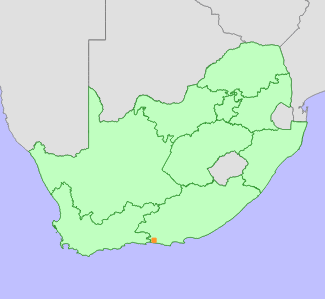|
Scientific Name | Helichrysum outeniquense Hilliard |
Higher Classification | Dicotyledons |
Family | ASTERACEAE |
National Status |
Status and Criteria | Critically Endangered D |
Assessment Date | 2016/03/31 |
Assessor(s) | J.H. Vlok, D. Turner, D. Underwood & D. van der Colff |
Justification | H. outeniquense is a very rare and localized habitat specialist, and was thought to be extinct after not being recorded in the wild for 70 years. A small subpopulation of fewer than 30 mature individuals was recently rediscovered near the type locality. It is not suspected to be declining, but ongoing monitoring and field surveys are needed. |
Distribution |
Endemism | South African endemic |
Provincial distribution | Eastern Cape |
Range | Tsitsikamma Mountains south of Joubertina. |
Habitat and Ecology |
Major system | Terrestrial |
Major habitats | Tsitsikamma Sandstone Fynbos |
Description | Peaty soil in valleys near springs and along streams. |
Threats |
| The subpopulation at the type locality has not been relocated for 70 years. A dam has been constructed in the stream where it was presumably collected, and it is suspected to be locally extinct. Downstream areas are severely infested with alien invasive black wattles, and surrounding areas are degraded due to agricultural expansion. The landowner at the recently rediscovered subpopulation is however clearing the wattles and interested in establishing a nature reserve at the site. |
Population |
This species was previously known only from the type collection, dating from 1947. Jan Vlok (expert field botanist from the southern Cape) searched for this species in the Tsitsikamma Mountains near Joubertina unsuccessfully over the past fifteen years, and it was thought to be extinct, particularly since the habitat at the type locality was lost to dam construction. In 2016, Dave Underwood, a volunteer of the Outramps Group belonging to the Custodians of Rare and Endangered Wildflowers (CREW) network, rediscovered the species further downstream from the type locality. H. outeniquense appears to be a fire ephemeral, and its emergence may have been triggered by a fire in the area a few years ago. Surveys of the site recorded three stands of less than 10 mature individuals, resulting in a total population count of less than 30 individuals confined to an area of <1.6 km². The population trend is not known, and ongoing monitoring is needed. It is not anticipated to continue to decline as the landowner is investing in conservation interventions such as alien plant clearing. Further field surveys, particularly following fires, are also needed in other similar habitat in the area to confirm whether or not other subpopulations exist.
|
Population trend | Stable |
Assessment History |
Taxon assessed |
Status and Criteria |
Citation/Red List version | | Helichrysum outeniquense Hilliard | CR D | 2017.1 | | Helichrysum outeniquense Hilliard | Extinct | Raimondo et al. (2009) | | Helichrysum outeniquense Hilliard | Indeterminate | Hilton-Taylor (1996) | |
Bibliography |
Goldblatt, P. and Manning, J.C. 2000. Cape Plants: A conspectus of the Cape Flora of South Africa. Strelitzia 9. National Botanical Institute, Cape Town.
Hilliard, O.M. 1983. Gnaphaliinae (First Part). In: O.A. Leistner (ed). Flora of Southern Africa 33 Asteraceae, Part 7 Inuleae, Fascicle 2:1-325. National Botanical Institute, Pretoria.
Hilton-Taylor, C. 1996. Red data list of southern African plants. Strelitzia 4. South African National Botanical Institute, Pretoria.
Manning, J.C. and Goldblatt, P. 2012. Plants of the Greater Cape Floristic Region 1: The Core Cape Flora. Strelitzia 29. South African National Biodiversity Institute, Pretoria.
Raimondo, D., von Staden, L., Foden, W., Victor, J.E., Helme, N.A., Turner, R.C., Kamundi, D.A. and Manyama, P.A. 2009. Red List of South African Plants. Strelitzia 25. South African National Biodiversity Institute, Pretoria.
|
Citation |
| Vlok, J.H., Turner, D., Underwood, D. & van der Colff, D. 2016. Helichrysum outeniquense Hilliard. National Assessment: Red List of South African Plants version . Accessed on 2025/05/31 |
 Comment on this assessment
Comment on this assessment


